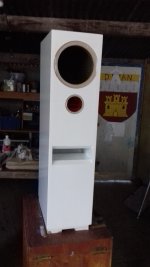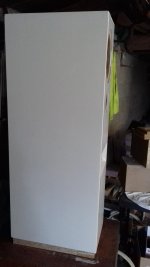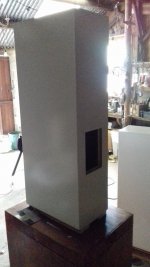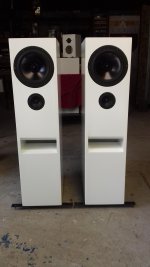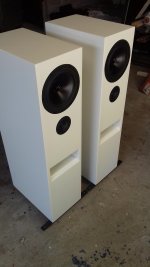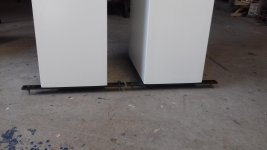Hi Wxn,the TL is not so fiddly. it's just take time . The two things delicate is to cut the wood so i did it on a store and make the hole for the loudspeaker which a friend of mine do it.
These look so good but will my rebuilt Heathkit W3M tube amplifiers provide adequate power at approx 16wpc? I'm very attached to them because they were built by a very dear friend and don't wish to go SS. Thanks.
It depends on how loud you listen. These are 82.4dB sensitive at 2.83v and 1m. I like to have at least 40w rms - but that’s just me. If you like the sound of tube amps, consider a tube preamp driving a low distortion SS amp. It will do whatever the tube asks it to do, including, sound like a tube 🙂
If 85dB is loud enough for you, then that’s 2w, leaving you with 9dB of headroom for peaks.
If 85dB is loud enough for you, then that’s 2w, leaving you with 9dB of headroom for peaks.
Both are the same sensitivity - the TL just goes down to 30Hz. The sensitivity is the natural result of an 87dB sensitivity woofer with -5dB baffle step loss for stand mount in open space (~4pi steradian). If you place it near a back wall, you get +3dB.
I cleaned up the amp display area in my lab using a shelf. Now all active amps can be accessed and connected in an instant. I have a Furman 8 tap linear multi-tap AVR toroidal power conditioner on the bottom rack. I also got a couple of mew amps to evaluate. My first tube amp, a Line Magnetic 211ia. I was very pleasantly surprised to learn that it can drive the big TLs just fine (32w into 8ohm ultra linear mode).
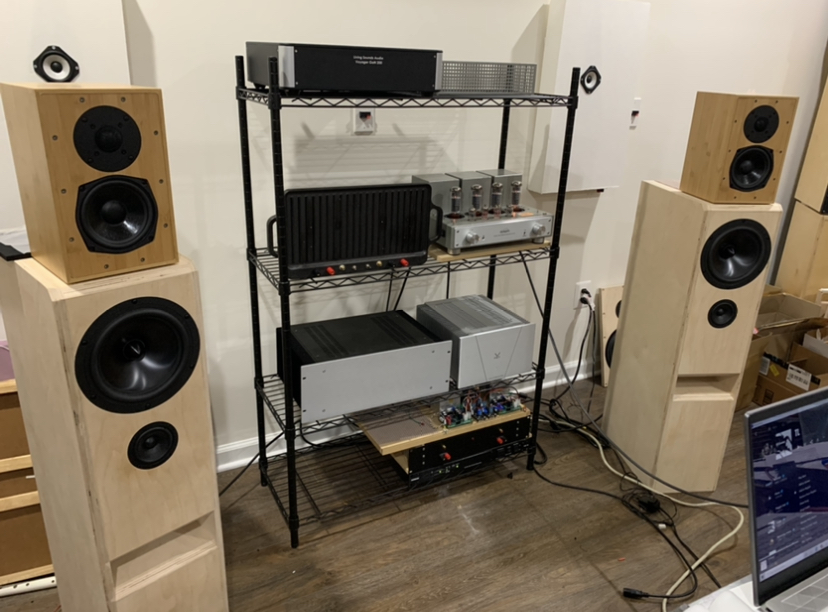
The tube amp also has a nice trick when you dim the lights too:
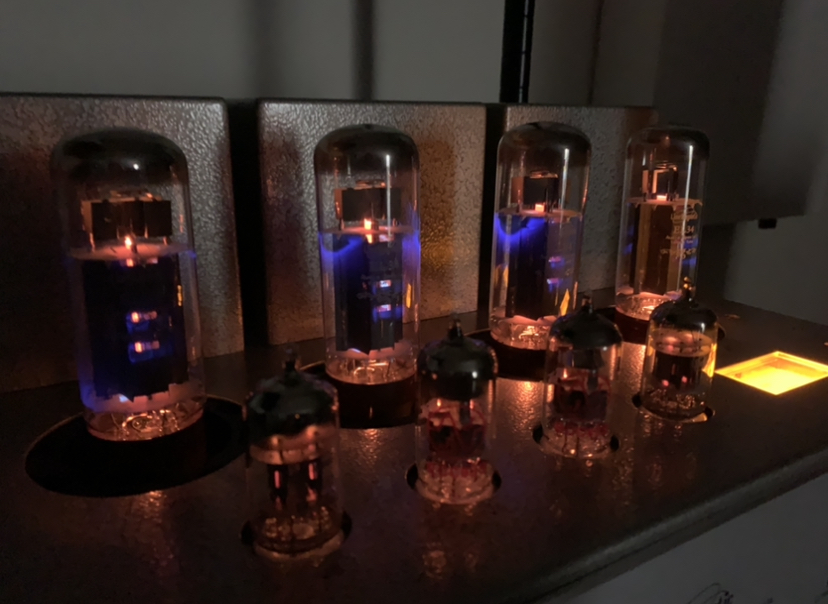
This is my very first transformer output coupled tube amp. I must say, it’s very pleasant and I can see then allure folks have with tube gear. It is very different then SS amps. The good news is that the impedance of the 10F/RS225 TLs appears to be very compatible with an EL84 push pull amp.
The tube amp also has a nice trick when you dim the lights too:
This is my very first transformer output coupled tube amp. I must say, it’s very pleasant and I can see then allure folks have with tube gear. It is very different then SS amps. The good news is that the impedance of the 10F/RS225 TLs appears to be very compatible with an EL84 push pull amp.
Last edited:
I cleaned up the amp display area in my lab[/URL] using a shelf….. The good news is that the impedance of the 10F/RS225 TLs appears to be very compatible with an EL84 push pull amp.
Looks great! Did you mean EL34?
The 10F/RS225 TLs being driven by the LuFo amp running a hot 5A bias current. Have a listen to the bass.
LuFo amp running at 6.0A bias current and 28.1v. Driving 10F/RS225 TL speakers. - YouTube
LuFo amp running at 6.0A bias current and 28.1v. Driving 10F/RS225 TL speakers. - YouTube
X,
Kudos on your new rack / shelf setup - it's very functional and survives your continuous R&D efforts well.
Whatever can be gleaned from the video, their is plenty of low frequency output with the LuFo amplifier in your system, and the bass sounds well articulated. Of course, the full extent of the playback quality is difficult to discern over a YouTube video, and I suspect that the actual listening experience will be much more pleasurable. 🙂
Again, great work and a big thanks to JPS64 for getting a superb PCB design done for the DIY community. Look forward to folks starting to build this amp.
I myself have this amp on my shortlist of builds... but we only have MOTs made for 230V AC line voltage, and these have a far higher DC resistance vs what you get with 110V mains line MOTs. So will have to wait and consider the best course of action (custom chokes or other options). In the meantime will be enjoying the developments and impressions from the community.
Kudos on your new rack / shelf setup - it's very functional and survives your continuous R&D efforts well.
Whatever can be gleaned from the video, their is plenty of low frequency output with the LuFo amplifier in your system, and the bass sounds well articulated. Of course, the full extent of the playback quality is difficult to discern over a YouTube video, and I suspect that the actual listening experience will be much more pleasurable. 🙂
Again, great work and a big thanks to JPS64 for getting a superb PCB design done for the DIY community. Look forward to folks starting to build this amp.
I myself have this amp on my shortlist of builds... but we only have MOTs made for 230V AC line voltage, and these have a far higher DC resistance vs what you get with 110V mains line MOTs. So will have to wait and consider the best course of action (custom chokes or other options). In the meantime will be enjoying the developments and impressions from the community.
Last edited:
moutik2,
Cabinets are looking very nice. Hope you can finish the speakers soon and start enjoying listening to them. 🙂
Cabinets are looking very nice. Hope you can finish the speakers soon and start enjoying listening to them. 🙂
well on tube world is a lot of power as tube have soft clipping , pentode IDHT in push pull with feedback ,must try SE DHT triode no fb like 300b or 211 ....😉My first tube amp, a Line Magnetic 211ia. I was very pleasantly surprised to learn that it can drive the big TLs just fine (32w into 8ohm ultra linear mode).
This is my very first transformer output coupled tube amp. I must say, it’s very pleasant
as PP 2A3 dht triode no fb or nice 6v6 in triode mode
Last edited:
There is a toggle switch for “Triode mode” and amp has only 15w.
@Moutik,
The TLs look great. Nice work on cabinet and paint. I forgot your were also making Rockville’s. Very cool. You are going to have quite a nice sounding setup when all this is done.
@Moutik,
The TLs look great. Nice work on cabinet and paint. I forgot your were also making Rockville’s. Very cool. You are going to have quite a nice sounding setup when all this is done.
Ok, a question for the collected woodworkers on this thread...
How many of you used simple butt joints on the wood and how many did rabbets/dadoes for the joining surfaces? Have any of the butt joints had issues, or is that method (butt joints, glued and clamped) proven sufficiently strong to hold it together? I have done these kinds of joints in all kinds of wood for shelving and other projects, so doing it isn't a problem, I'm just not sure how helpful it would be (and I know it will be a bit of a pain to execute).
I'm trying to layout all the panels and determine how many 60" square sheets of the Baltic (13 ply in this case) will be required, but it will be different depending on the joinery I use.
In short, is the fancy joinery necessary or even worth the effort? Please post your opinions, observations and thoughts. And, as always, thanks for the insight!
How many of you used simple butt joints on the wood and how many did rabbets/dadoes for the joining surfaces? Have any of the butt joints had issues, or is that method (butt joints, glued and clamped) proven sufficiently strong to hold it together? I have done these kinds of joints in all kinds of wood for shelving and other projects, so doing it isn't a problem, I'm just not sure how helpful it would be (and I know it will be a bit of a pain to execute).
I'm trying to layout all the panels and determine how many 60" square sheets of the Baltic (13 ply in this case) will be required, but it will be different depending on the joinery I use.
In short, is the fancy joinery necessary or even worth the effort? Please post your opinions, observations and thoughts. And, as always, thanks for the insight!
Simple butt joints are way strong enough if your wood is precisely cut and you use modern glue -- lots of PVA or a more judicious amout of urethane. I use a plate jointer with biscuits to hold alignment, and that stops most sliding problems. Harbor Freight sells one cheap that works well as long as you don't try to do anything fancy. Fancier joints from miters on up look very nice and may be stronger, but well done butt joints are strong enough. Caulk the joins internally for a belt-and-suspenders approach to sealing.
Skip
Skip
Another vote for butt joints. I've built more speaker cabinets than I can count. Never had an issue with butt joints.
@kking85743,
It's my habit to use a shallow rabbet. Not for strength but for easier alignment during assembly.
It's my habit to use a shallow rabbet. Not for strength but for easier alignment during assembly.
Hi All,
I'm keen to build the TL version of this design but have 3 questions on the physical build - my first TL build.
1/ Don't see any baffle edge roundover on peoples cabinets - is there a reason for this ?
2/ Haven't noticed any corner bracing along outside panel internal edges - would the area of the bracing be sufficient to throw out the required pipe cross section calcs ? (don't have a feeling for the design sensitivity to this)
3/ Have read that cabinet stuffing is fairly critical on TL boxes. Is there any detail posted on the recommended stuffing approach for this design ? (I'd normally use auto panel deadener, egg crate foam & poly fibre - but unsure of where & how much in a TL box)
Thx in advance.
I'm keen to build the TL version of this design but have 3 questions on the physical build - my first TL build.
1/ Don't see any baffle edge roundover on peoples cabinets - is there a reason for this ?
2/ Haven't noticed any corner bracing along outside panel internal edges - would the area of the bracing be sufficient to throw out the required pipe cross section calcs ? (don't have a feeling for the design sensitivity to this)
3/ Have read that cabinet stuffing is fairly critical on TL boxes. Is there any detail posted on the recommended stuffing approach for this design ? (I'd normally use auto panel deadener, egg crate foam & poly fibre - but unsure of where & how much in a TL box)
Thx in advance.
- Home
- Loudspeakers
- Full Range
- 10F/8424 & RS225-8 FAST / WAW Ref Monitor
